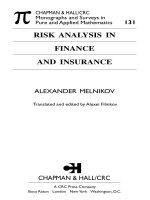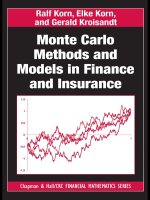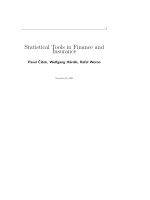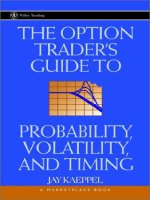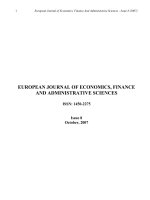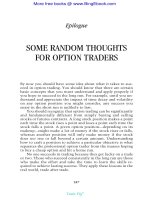Probability finance and insurance
Bạn đang xem bản rút gọn của tài liệu. Xem và tải ngay bản đầy đủ của tài liệu tại đây (7.7 MB, 252 trang )
"ze Leung Lai Hailiang Yang Siu Pang Yung
PROBABILITY, FINANCE
AND INSURANCE
Proceedings of a Workshop at the University of Hong Kong
PROBABILITY, FINANCE
AND INSURANCE
This page is intentionally left blank
PROBABILITY, FINANCE
AND INSURANCE
Proceedings of a Workshop at the University of Hong Kong
Hong Kong
15 - 17 July 2002
editors
Tze Leung Lai
Stanford University, USA
Hailiang Yang
Siu Pang Yung
The University of Hong Kong, China
Y|j5 World Scientific
NEW JERSEY • LONDON • SINGAPORE • BEIJING • SHANGHAI • HONGKONG • TAIPEI • CHENNAI
Published by
World Scientific Publishing Co. Pte. Ltd.
5 Toh Tuck Link, Singapore 596224
USA office: Suite 202,1060 Main Street, River Edge, NJ 07661
UK office: 57 Shelton Street, Covent Garden, London WC2H 9HE
British Library Cataloguing-in-Publication Data
A catalogue record for this book is available from the British Library.
PROBABILITY, FINANCE AND INSURANCE
Proceedings of a Workshop at the University of Hong Kong
Copyright © 2004 by World Scientific Publishing Co. Pte. Ltd.
All rights reserved. This book, or parts thereof, may not be reproduced in any form or by any means,
electronic or mechanical, including photocopying, recording or any information storage and retrieval
system now known or to be invented, without written permission from the Publisher.
For photocopying of material in this volume, please pay a copying fee through the Copyright
Clearance Center, Inc., 222 Rosewood Drive, Danvers, MA 01923, USA. In this case permission to
photocopy is not required from the publisher.
ISBN 981-238-853-2
Printed in Singapore.
PREFACE
This volume contains about half of the papers that were presented at
the Workshop on Probability with Applications to Finance and Insurance
on July 15-17, 2002 at The University of Hong Kong. Thirty-one invited
speakers from mainland China, Hong Kong, Taiwan, Singapore, Australia
and the United States gave talks at the workshop, which brought together
many leading researchers in probability theory, stochastic processes, mathematical finance and actuarial science. The participants discussed important current issues and exchanged ideas, and there was fruitful interaction
between researchers from different fields.
The workshop was supported by the Institute of Mathematical Research
at The University of Hong Kong. We are particularly grateful to Professor
Ngaiming Mok, the Institute's Director, for suggesting the idea of a workshop of this kind and for his generous support. The workshop was also
sponsored by the Hong Kong Mathematical Society. We also thank Professor Eric Chang of the Department of Finance, Dr. Kai Wang Ng of the
Department of Statistics and Actuarial Science, Professor Man Keung Siu
and the staff of the Department of Mathematics for their help and support.
We are deeply grateful to Professor Inchi Hu and Dr. Bing-Yi Jing of the
Hong Kong University of Science and Technology and Professor Qi-Man
Shao of the University of Oregon and the National University of Singapore
for working closely with us on the Organizing Committee in planning and
making arrangements for the workshop. We want to express our gratitude to the authors for their careful preparation of the manuscripts, which
have made publication of this volume possible, and to Professors Gerold
Alsmeyer, Beda Chan, Wai Ki Ching, Wai Keung Li, Qihe Tang and Lixing Zhu for their help in the refereeing process. Thanks are also due to
Ms. Ada Lai and Mimi Lui for their valuable administrative and technical
assistance in the preparation of the Proceedings.
T. L. Lai, H. Yang and S.P. Yung
Stanford and Hong Kong
V
LIST OF PARTICIPANTS
Andrew Carverhill
The University of Hong Kong
Hong Kong
Eric C. Chang
The University of Hong Kong
Hong Kong
Kani Chen
Hong Kong University of Science
and Technology
Hong Kong
Ngai-Hang Chan
The Chinese University of Hong
Kong
Hong Kong
Sung Nok Chiu
Hong Kong Baptist University
Hong Kong
Kwok Pui Choi
National University of Singapore
Singapore
August Chow
Office of the Commissioner of
Insurance
Hong Kong
Cheng-Der Fuh
Institute of Statistical Science
Academia Sinica
Taipei
Fu Zhou Gong
Institute of Applied Mathematics
Chinese Academy of Sciences
Beijing
Minggao Gu
The Chinese University of Hong
Kong
Hong Kong
Inchi Hu
Hong Kong University of Science
and Technology
Hong Kong
Yaozhong Hu
University of Kansas
Lawrence, KS 66045
vu
Hsien-Kuei Hwang
Institute of Statistical Science
Academia Sinica
Taipei
Bing-Yi Jing
Hong Kong University of Science
and Technology
Hong Kong
Yue-Kuen Kwok
Hong Kong University of Science
and Technology
Hong Kong
Tze Leung Lai
Stanford University
Stanford, CA 94305
Wai Keung Li
The University of Hong Kong
Hong Kong
Szu-Lang Liao
Banking and Financial Markets
National Cheng-Chi University
Taipei
Tiong Wee Lim
National University of Singapore
Singapore
Shiqing Ling
Hong Kong University of Science
and Technology
Hong Kong
Ngaiming Mok
The University of Hong Kong
Hong Kong
Kai Wang Ng
The University of Hong Kong
Hong Kong
Qi-Man Shao
University of Oregon
Eugene OR 97403-1217
Elias Sai Wan Shiu
University of Iowa
Iowa City, Iowa 52242-1409
Man Keung Siu
The University of Hong Kong
Hong Kong
Chun Su
University of Science and
Technology of China
Hefei
Qiying Wang
Australian National University
Canberra, ACT, 0200
Australia
Ching-Zong Wei
Institute of Statistical Science
Academia Sinica
Taipei
Michael Wong
The Chinese University of Hong
Kong
Hong Kong
Liming Wu
Wuhan University
Wuhan
Kai-Nan Xiang
Hunan Normal University
Changsha
Hailiang Yang
The University of Hong Kong
Hong Kong
Xiao-Guang Yang
Institute of System Science
Chinese Academy of Sciences
Beijing
Yi Ching Yao
Institute of Statistical Science
Academia Sinica
Taipei
Zhiliang Ying
Columbia University
New York, NY 10027
Siu Pang Yung
The University of Hong Kong
Hong Kong
Prank Zhang
Morgan Stanley
New York
Lixin Zhang
Zhejiang University
Hangzhou
Xunyu Zhou
The Chinese University of Hong
Kong
Hong Kong
CONTENTS
Preface
v
List of Participants
vi
Limit theorems for moving averages
1
Tze Leung LAI
On large deviations for moving average processes
15
Liming WU
Recent progress on self-normalized limit theorems
50
Qi-Man SHAO
Limit theorems for independent self-normalized sums
69
Bing-Yi JING
Phase changes in random recursive structures and algorithms
82
Hsien-Kuei HWANG
Iterated random function system: convergence theorems
98
Cheng-Der FUH
Asymptotic properties of adaptive designs via strong approximations .112
Li-Xin ZHANG
Johnson-Mehl tessellations: asymptotics and inferences
136
Sung Nok CHIU
Rapid simulation of correlated defaults and the valuation of basket default
swaps
150
Zhifeng ZHANG, Kin PANG, Peter COTTON, Chak WONG and
Shikhar RANJAN
Optimal consumption and portfolio in a market where the volatility is
driven by fractional Brownian motion
164
Yaozhong HU
MLE for change-point in ARMA-GARCH models with a changing drift 174
Shiqing LING
Dynamic protection with optimal withdrawal
195
Hans U. GERBER and Elias Sai Wan SHIU
Ruin probability for a model under Markovian switching regime
206
Hailiang YANG and G. YIN
Heavy-tailed distributions and their applications
218
Chun SU and Qihe TANG
The insurance regulatory regime in Hong Kong (with an emphasis on the
actuarial aspect)
237
August CHOW
ix
LIMIT THEOREMS FOR M O V I N G AVERAGES
TZE LEUNG LAI
Stanford University, CA, USA
E-mail:
Moving averages have many important statistical applications, particularly in
change-point problems and signal detection (for which the moving averages are
taken over spatial domains). Herein we give a review of limit theorems for moving averages and describe some recent developments motivated by applications to
signal detection and change-point problems.
1. Introduction
Let £,£i,£2i-" be i.i.d. random variables, and let Sn = £f =1 £i, So = 0,
Sn(k) = Sn — Sn_fe. The window size k of the moving average k~1Sn(k)
can be time-invariant or can vary with n, yielding fc~15n(fcn) as the moving
average. The special case kn = n reduces to the usual sample mean Sn/n,
for which one has the Kolmogorov and Marcinkiewicz-Zygmund strong laws:
n~1Sn —> 11 a.s. 4=> E\$\ < oo and E£ = n,
rTl/vSn
-> 0 a.s.
(l
(1)
(2)
and the law of the iterated logarithm when E£ = 0:
limsup n _ >00 S , n /{2nloglogn} 1,/2 = a and
liminf = -a2 a.s. <=$> E£2 = a,
(3)
cf. Chow and Teicher (1988) and Strassen (1966). Extensions of (l)-(3) to
general moving averages are given in Section 2, where their connections to
other summability methods for i.i.d. random variables are also discussed.
For kn ~ alogn, Erdos and Renyi (1970) considered the running maximum max.kn
max Sj(kn)/kn
1
-> /?„ a.s.,
(4)
2
where b = (3a solves the equation e~ 1 / a = inf t >oe _ t 6 i?e t f . This is often
called the Erdos-Renyi-Shepp strong law, as Shepp (1964) proved earlier
the closely related result maxkn
(1986) subsequently proved the following refinement: Let t = ta be the
unique solution of (EXetX)/Eetx
= /?„. Then
p-Um (logfc n ) -1 { max Sj{kn) = p-lim (logfc„)"~1<
(3akn\
max 5,(fc,) - Pakn \
<. kn
J
= -V(2ta),
(5)
where "p-lim X n = i " means that Xn converges to x in probability as
n —* oo.
Whereas these results are related to windows of size [a log n] or smaller,
recent applications to efficient change-point detection involve more general
window sizes and also nonlinear functions g(Sj(k)/k) of moving averages.
There is now a comprehensive theory for the asymptotic distributions of
Mn =
fcejm«^n
kg{Si{k)/k)
(6)
used in fixed-sample change-point problems, and of the stopping rule
Tc = inf in:
max
kg(Sn(k)/k)
L fteJ(e), k
> c)
(7)
i
used in sequential change-point detection. Here Sn is a d-dimensional random walk, g : R d —> R and Jn,J(c) are subsets of {1,2,...}. Sections 3
and 4 give a brief review of this theory, in which a key ingredient is an
asymptotic approximation to boundary crossing probabilities for moving
averages. Section 3 deals with the case where the window sizes involved
require large deviation approximations, like those used in the derivation of
the Erdos-Renyi-Shepp law (4) and its refinement (5). Section 4 considers
the case in which the window sizes require moderation approximations.
Note that as we let both the time n and the window size k vary, the
random process {Sn(k) :n>k} has a two-dimensional index (k,n). More
generally, Section 5 considers sums of independent random variables with
multi-dimensional indices and more general random fields and shows how
the results of Section 4 can be extended to this setting.
2. Strong limit theorems for moving averages
In this section we describe analogue of the strong laws and the law of
the iterated logarithm for moving averages, presenting two kinds of re-
3
suits. The first applies to windows of fixed size k, and the second applies
to time-varying window sizes fc„, as n —> oo. For the former, we also
generalize fc-1Sn(fc) to weighted sums of the form S^LiCn-j^, in which
c = (co,ci,...) € £2 (i.e., S g 0 c ? < oo), noting that fe_15n(fc) corresponds
to the case Co = c\ = ... = Ck-i = 1/fc and c* = 0 for i > k. Analogous
to (l)-(3), necessary and sufficient moment conditions for £ are given for
these almost sure limits (or limsup,liminf) of the moving averages.
We first consider the case of windows of fixed size k. Chow and Lai
(1973) proved the following analogue of (2): For p > 1,
n-^pSn(k)
-> 0 a.s. <s> E\£\p < oo
-> 0 a.s. for all c ^ 0 with Yffc2 < oo,
•» n-VfYZcn-iti
S n (fc)/logn ->• 0 a.s. & Eem
(8)
< oo for all t > 0
<S> E^Cn-i^/logn -> 0 a.s. for all c ^ 0 with £g°cf < oo.
(9)
For fixed k, {Sn(k), n > k} is a fc-dependent stationary sequence; more generally, we expect Yn := £™c„_,£j to share the same almost sure (a.s.) limiting properties. In particular, Lai (1973) proved the following upper/lower
class characterization of boundaries bn for Yn when the £ n are Gaussian,
analogous to the case of i.i.d. standard normal Yn.
T h e o r e m 2 . 1 . Suppose £ is standard normal, a2 := ££L0c? < oo and
E g n c ? = O((logg)~ 2 ). Let bn be an eventually nondecreasing sequence of
positive numbers. Then
f "
]
P< 2.°n-i^i
— bn infinitely often >
oo
= 0 (or 1) if Y2bnle~bl/{2°2)
< (°r
=)oo.
n=l
We next consider the case k = kn —> oo as n —» oo. A continuous
function / : (0, oo) —> (0, oo) is called self-neglecting if f(x) = o(x) and
f{x + tf(x))/f(x)
—> 1 as x —> oo, for all t e R. It is said to be of bounded
increase if there exist A > 1,C, a and £o such that f(Xx)/f(x)
< C\a
for all 1 < A < A and x > x0. Suppose / is continuous, increasing and
self-neglecting and the derivative of f~l is of bounded increase. Bingham
and Goldie (1988) proved the following analogue of (1) for moving averages
with window sizes kn = f(n), assuming that lim^-,,^ f(x) — oo:
Sn(f(n))/f{n)
-> fi a.s. & E/ _ 1 (|£|) < oo and E£ = \x.
(10)
4
They also showed that this result is closely related to Riesz summability of
{£ n }. Bingham and Rogers (1991) gave a survey of this and other summability methods for i.i.d. random variables, including iterated-logarithm-type
results and necessary and sufficient moment conditions for Cesaro, Abel,
Euler and Borel summability considered by Lai (1974a).
The following analogue of (3) for Sn(kn) was proved by Lai (1974b)
when
bna with 0 < a < 1:
limsup„^ 0 0 5 n (fc n )/(fc r i logn) 1 / 2 = {2(1 - a ) } 1 / 2 ^ and
liminf = -{2(1 - a)}1'"2a a.s. <£> E£2 = a2 and
Em2/a(log+
fcl
+ l)'1/a}
< oo.
(11)
Under additional moment conditions, Csorgo and Revesz (1981, Chapter 3)
showed that for fcn/logn —* oo,
limsup„^ TO ( i < f e < m a x <
= a a.s.
+loglogn]} 1 / 2
(12)
In the special
bna, the denominator in (12) is of the order
{2fcn(l — a)logn} 1 / ' 2 , in agreement with (11). This was further generalized
by de Acosta and Kuelbs (1983) to the case where £ assumes values in a
separable Banach space, for which they showed under certain assumptions
that with probability 1,
(i) {Sj(kn)/bn : 1 < k < kn, k < j < n} is relatively compact eventually and its set of limit points is contained in the unit ball K of the
reproducing kernel Hilbert space of £(£)> a n d
(ii) the limit set of {Sj{kn)/bn : kn < j < n} is K under additional
assumptions, where bn = {2fc„[log(n/fcn) + log log n]} 1 / 2 .
It is interesting to compare Theorem 2.1 with (12) and its extensions
by Csorgo and Revesz (1981) and de Acosta and Kuelbs (1983). Although
both are (single) logarithm laws (related to the tail of the normal distribution), Theorem 2.1 requires & to be normal as the fixed window size does
not provide enough averaging, while (12) only requires moment (but not
distributional) assumptions on & since the large window size kn yields an
asymptotically normal Sn(kn). In the next two sections, we make use of
large or moderate deviation approximations to boundary crossing probabilities of moving averages and the associated asymptotic distributions of Mn
and Tc in (6) and (7), depending on the magnitude of the window sizes in
Jn or J{c).
5
3. Large deviation approximations for logarithmic window
sizes
Moving averages play a fundamental role in the problem of detection and
diagnosis of abrupt changes in a stochastic system on the basis of sequential
observations has many applications, including fault detection and diagnosis
in complex dynamical systems and industrial processes, integrity monitoring of navigation systems, and radar and sonar signal processing (cf. Basseville and Nikiforov (1993), Prank (1991), Nikiforov (1996)). When the observations Xt are independent with a common density function /o for t < v
and with another common density function / i for t > u, Shiryayev (1978)
formulated the problem of optimal sequential detection of the change-time
i / i n a Bayesian framework, by putting a geometric prior distribution on v
and assuming a loss of c for each observation taken after v and a loss of 1
for a false alarm before v. He used optimal stopping theory to show that
the Bayes rule triggers an alarm as soon as the posterior probability that
a change has occurred exceeds some fixed level. Instead of the Bayesian
approach, Lorden (1971) used the minimax approach and showed that subject to the constraint that the expected duration to false alarm be at least
7, the CUSUM procedure (7) with
J(c) = {1,2,...}, g(x) = x, Sn(k) = £? = n _ f c + 1 log(/i(X t )// 0 (X t ))
(13)
asymptotically minimizes the "worst-case" detection delay. Lorden's
method is to relate the CUSUM procedure to certain one-sided sequential
probability ratio tests which are optimal for testing /o versus f\. Instead
of studying the optimal detection problem via sequential testing theory,
Moustakides (1986) was able to formulate the worst-case detection delay
problem subject to a false alarm constraint as an optimal stopping problem and to prove that Page's CUSUM rule is a solution to the optimal
stopping problem. Lai (1995, 1998, 2000) recently extended the optimality
theory in sequential change-point detection far beyond the simple models
considered in the literature, introduced new performance criteria and derived asymptotically optimal detection rules which are based on certain
nonlinear functions of moving averages with a variety of window sizes, as
in (7).
To begin with, consider the special case g(x) = \\x\\ and Jn = J(c) =
{1,2,...} in (7) and (6). Under certain conditions, Chan and Lai (2003a)
have shown that there exist q 6 { 0 , . . . , d} and r > 0 (depending on g) such
that when the Xt are i.i.d. (corresponding to v = oo) with a finite moment
6
generating function in some neighborhood of the origin,
e~ c / r (c/r) 9 / , 2 T c has a limiting exponential distribution as c —> oo, (14)
Af„ — r{log n + (q/2) log log n} has a limiting Gumbel-type distribution
as n —+ oo.
(15)
In the case of a one-dimensional random walk with i.i.d. increments and
g(fi) = n, (15) with q = 0 has been established by Iglehart (1972) in
the context of longest waiting times in a GI/G/l queue and by Karlin
et al. (1990) in the context of high-scoring segments in a DNA or amino
acid sequence. The corresponding result (14) in this case follows from
Siegmund's (1988) result on the CUSUM rule.
The post-change density function fi in the CUSUM rule defined by (7)
and (13) is assumed to be known. In practice it is usually unknown and
is modeled by a parametric family of density functions fg with respect to
some dominating measure. The exponential family fe{x) — e9 x-^(e) covers
most parametric models that are used in practice, for which we can choose
6 = 0 and tp(0) = 0 (after reparameterization if necessary) for the baseline
distribution. Without knowing the post-change parameter, a natural way
is to estimate it by maximum likelihood based on Xn,..., Xn-k+i- For
the exponential family, this leads to the GLR (generalized likelihood ratio)
CUSUM rule of the form (7) with & = Xt and
g(x) = sup(6»':r - V>(#)) = 0'xx - ij}(6x), where 6X = (Vt/>) -1 (x).
(16)
9
In particular, when d = 1 and the Xt are i.i.d. standard normal, g(x) =
x2/2, for which Siegmund and Venkatraman (1995) showed that as c —> oo,
(,\fc e"cTc has a limiting exponential distribution with mean 1,
(17)
where C = ^ 1 / 2 Jo°° xv2{x)dx and v(x) = 2 : z r 2 e x p { - 2 £ f r T 1
$(—Xy/n/2)} for x > 0, in which $ denotes the standard normal distribution. Note that (17) is a special case of (14) with r = q = 1. The
asymptotic theory in Chan and Lai (2003a,b) concerning (6) and (7) unifies these previous results and also leads to definitive solutions of a variety
of change-point detection problems, giving in particular (i) the extension
of i.i.d. to Markov-dependent & (so that more general stochastic systems
can be treated), and (ii) suitable choice of g and Jn or J{c) in (6) or (7) to
achieve both statistical and computational efficiency.
A unified approach in Chan and Lai (2003a) to derive (14) and (15) is
based on integrating saddlepoint approximations for Markov random walks
7
with respect to certain measures over some tubular neighborhood of an
extremal g-dimensional manifold in R d , which incorporates both the critical
temporal and spatial components of the problem, yielding an asymptotic
formula for the following boundary crossing probability:
P { max kg(Sn(k)/k)
> c for some n < /3c}
5c
-(c/r^ce-'/^cS-CS).
(18)
where 0 < S < a < /? and Q, 5 (i = 1,2) are constants that can be expressed
as integrals over the extremal manifold. To see how (14) can be derived
from (18) in the case of i.i.d. & and J(c) = {k : 5c < k < ac}, let x > 0,
m = (Q, \)~l{c/r)~ql2eclTx,
and partition the interval [0,m] into K ~
m/(f3c) disjoint intervals I\,...,IK
with equal length /3c(l + o(l)). Then
the events
Aj = \
max kg(Sn(k)/k)
> c for some n S /,• and n — k € Ij \
I 5c
)
are independent and have the same probability pc. Letting Aj denote the
complement of Aj, it follows from (18) that
P(nf=1Aj)
= (1 -Pcf
~ e-**° - exp{-:r[l - C S C S r ^ S l / r }
as c ^ oo. Hence P(UJLi^i) -> 1 ~ exp{-x[l - G 3 C S ) - 1 C S ] M .
Bj = -^ max kg(Sn(k)/k))
> c for some n e 7,-+i and n — k £
Let
L\.
Then by a similar argument involving a straightforward modification of
(18), it can be shown that P{{jf=1Bj) -> 1 - exp[-(/3<^)- 1 C^a;/r] as
c —> oo for sufficiently large /3 (with /? > a). Taking /? arbitrarily large,
since
P ( u f = 1 ^ ) < P{TC
P(uf = 1 A,) + P ( u f = 1 B j ) ,
it then follows that
P{TC < m} -» 1 - e~x as c -> oo.
(19)
Since P{TC <n} = P{Mn > c}, (15) follows from (14) by using (19) with
c = r{logn + (g/2)loglogn} + t to evaluate the survival function at t of
the limiting distribution in (15).
8
4. Window sizes associated with moderate deviation
approximations
The preceding approach involves the moment generating function (or the
exponential transform kernel in the Markov case) of the increments of
Sn and therefore requires compete specification of the distribution of the
£„. Many applications, however, involve unmodeled dynamics and have
led to the so-called "asymptotic local approach" in the fault detection
literature (cf. Benveniste et al. (1987), Basseville and Nikiforov (1993),
Zhang et al. (1994)). Suppose the detection statistics & are such that
for every fixed fi, { 7 - 1 / 2 Yli=\ &> * ^ 0} converges weakly under Py./^
to {Wfj,(t),t > 0} as 7 —> 00, where {W M (t),t > 0} is a multivariate
Gaussian process with independent increments such that EWp(t) = /ii
and Cov(WM(£)) = tV. The baseline probability measure is PQ that corresponds to 11 = 0. Let A7 = A/^/7. In particular, consider the CUSUM rule
T 7 = inf{n : maxi
and therefore Ell//^{T1)
~ ^ET^C).
When A is not specified in advance,
maximizing the CUSUM statistics X^Sn(k) — kX^VX7/2 over A7 yields
S^{k)V~lSn(k)/2k,
which leads to the following window-limited rule proposed by Zhang et al. (1994):
f7 = inf{n > 6 l 7 :
max
5j(fc)Vr_15n(fc)/2fc > c},
(20)
b\i
with 62 > &i > 0. The preceding asymptotic approach has been called "local" because it is based on weak convergence of T 7 / 7 or T 7 / 7 under
P^
to the same limiting distribution as that in the canonical setting of independent normal V~l/2£t, when A7 is of the order X/y/j in the CUSUM rule
or when the windows are of the form 617 < k < 627 in (20). Such choice of
window size (or A7) makes T 7 (or T 7 ) very inefficient for detecting changes
that are considerably larger than the 0 ( 7 - 1 / 2 ) order of magnitude for "local" changes. Lai and Shan (1999) proposed another approach based on
moderate deviations theory (instead of weak convergence approximations)
to analyze boundary crossing probabilities associated with detection rules
of the general form
T* = inf{n > M : max £%(k)V^Sn{k)/2
> c},
(21)
where c ~ log7 (instead of bounded c in the asymptotic local approach),
JM = {Mj • J € J(c)}, J(c) = { 1 , . . . , M } U {[
9
1, M ~ ac, j * = min{j : [wJM] > 7} ~ c/logw, M/c —• 00 (to ensure that
the sums J2"_fc & become approximately Gaussian in the moderate deviations sense), and Vn,k is an estimate of the asymptotic covariance matrix
of Sn(k) under P0. Note that V_1/k in (20) corresponds to the inverse of
Vn,k = kV. In many applications V is unknown and needs to be estimated.
Even when V is known, using an estimate Vn,k instead of kV offers the
flexibility of making adjustments for non-normality in treating (21) under
PQ as if it were a window-limited GLR rule with independent standard
normal V - 1 / , 2 £ti where the £t are actually dependent random vectors with
unknown distributions. Grouping the observations into batches as in (21)
arises naturally in quality control applications, in which samples of size M
are taken at regular intervals of time.
The moderate deviation approximations to boundary crossing probabilities associated with (21) involve corresponding probabilities for Gaussian
processes. When the £t are i.i.d. random variables, the associated Gaussian
process is Brownian motion B(t) and the increments of Sn are independent
and approximately normal in the moderate deviations sense. In this case,
the following moderate deviations counterpart of (18) holds, as has recently
been shown by Chan and Lai (2003b): For 0 < a\ < 02 < a,
P{{h - ti)~ 1 / 2 [B(t 2 ) - B(h)} > c for some
0
max
k~1'2Sn{k)
> c for some n < anc \
~ yl>(c){cAH)[a{a? - a^1) - log(o 2 /oi)]
(22)
if nc/c6 —> 00, where ip(x) = (2nx2)~1^2e"x I2 for x > 0, noting that
P{N(0,1) > x} ~ i>(x) as x —> 00. For multivariate Markov random walks,
a more general form of (22) involving multivariate Gaussian processes also
holds and can be used to establish moderate deviation analogues of (14)
and (15); see Chan and Lai (2003b). For applications to change-point
detection, whereas (14) and (15) require the distribution of the underlying
random variables to be completely specified under the null hypothesis of
no structural change, (22) and its multivariate and Markovian extensions
enable one to take a nonparametric approach that does not require such
specification. Moreover, as moderate deviation approximations only involve
the covariance structure of the limiting Gaussian process, they are more
flexible and easier to implement than large deviation approximations.
10
5. Maxima and boundary crossing probabilities of
asymptotically Gaussian random fields
Csorgo and Revesz (1979) proved a weaker version, in terms of an upper
bound for the probability but not its precise asymptotics, of (22) on the
increments of Brownian motion. Noting that X(t) := (t2 — t\)~ll2{B{t2) B{t\)] is a Gaussian random field on the domain {£ = (£i,£2) : 0 < £1 < £2}:
Chan and Lai (2003c) considered more general Gaussian random fields.
Moreover, in order to be able to extend the result from the Gaussian random field to some process close to it in a certain sense (such as moderate
deviations), they came up with the following formulation of "asymptotically
Gaussian" random fields and developed asymptotic formulas for related
boundary crossing probabilities, of which (22) is a special case. For vectors
t,u € R d , the relation t < u denotes U < m for all i and t < u denotes
U < Ui for all i. For C > 0, let Jt,< = I\Li [*». U + 0 - L e t W ( u ) : u € Rd}
be a continuous Gaussian random field such that
Wt(0) = 0, E[Wt{u)} = - | | u | r r t ( u / | M | ) / 2
cov{Wt{u),Wt{v))
and
a
= [||u|| r t (tt/||ti||) + ||i;|rr t (t;/||t;||)
-\\u-v\\art((u-v)/\\u-v\\)}/2,
where || • || denotes Euclidean norm and rt : S
function satisfying
sup \rt(v) — ru(v)\ —• 0
d_1
(23)
—> R + is a continuous
asu->t.
(24)
For c > 0, let Xc be random fields such that EXc{t) = 0, EX%{t) = 1
for all c and £. Let D be such that [D]s := {£ + u : t S D, \\u\\ < 6} is a
subset of the domain of Xc for some 5 > 0 and all c large enough. Define
pc(t,u) = E[Xc(t)Xc(u)\ and assume that
(C)
pc(t, t + u) = 1 - (1 + 0(l))HaL(|M|)rt(«/|M|)
uniformly over £ e [D]$ and compact sets of u / A c > 0, and that the
following conditions also hold uniformly over £ G [D]s for c large enough:
(Al)
P{Xc(t)
> c - y/c} ~ ^(c - y/c)
uniformly over positive, bounded values of y. The convergence in (24) is
assumed to be uniform in £ € [D]g, with sup te [ £) ] J)1 , e s' i - 1 rt(v) < °°> a n ( i
for a > 0 and positive integers m,
{c[Xc(t + akAc) - Xc(t)} :0
=4> {Wt(ak)
:0
m}\Xc{t)
=
c-y/c
11
uniformly over positive, bounded values of y, where we use "\Xc(t) = c —
y/c" to denote that the distribution is conditional on Xc(t) = c — y/c. In
addition, there exists a positive function h such that limy_*oo h(y) = 0 and
(A3)
P{Xc{t + uAc) > c - 7/c, Xc(t) < c - y/c} < h{y)ijj{c)
for all u > 0 and 7 > 0, and there exist non-increasing functions Na on R +
and positive constants j a such that 7 a —> 0 and Na(ja) + Jx wsJVa(7a +
u) duj — o(ad) as a -* 0, and
(A4)
P{ sup Xc(t + uAc) > c, Xc(t) < c - 7/c} < iV 0 ( 7 )V(c),
0
for all 7 a < 7 < c and s > 0. Moreover, there exists a non-increasing
function / : [0,oo) -> R+ such that /(||r||) = 0(e _ ll r H P ) for some p > 0
and for all 7 > 0 and c sufficiently large,
(A5)
P{Xc(t)
> c - 7/c, Xc(t + uA c ) > c - 7/c} < rl>(c - 7/c)/(||u||)
uniformly in t and t + uAc belonging to [D]$.
Note that (Al) says that the "moderate deviation" event {Xc(t) >
c — y/c} has probability like that of a standard normal. Whereas this refers
to the marginal distribution of Xc(t), the joint distribution is assumed
in (A2) to be asymptotically normal in the sense of weak convergence for
local increments conditioned on Xc(t) = c—y/c. Note that the same a, L(-)
and rt(-) appear in (C) and the mean and covariance functions (23) of the
limiting Gaussian field Wt(-) in (A2). In fact, if Xc = X is a Gaussian field
satisfying condition (C), then (A2) holds; see Corollary 2.7 of Chan and Lai
(2003c). Assumptions (A3)-(A5) are mild technical conditions under which
the probability of sup u € / t KA Xc(u) exceeding c can be computed via (Al)
and (A2), yielding the following asymptotic formulas.
Theorem 5.1. (i) Let K > 0. Assume (C) and (Al)-(A4).
P{
sup
Xe(u) > c} ~ V(c)[l + HK(t)]
Then
(25)
«6fl,K4c
uniformly overt G [D}$, where HK(t) = /0°° e 3 'P{sup 0 < u . <Ar Wt(u) > y} dy
is finite and uniformly continuous int £ [D}$.
(ii) Assume (C) and (Al)-(A5).
Then H{t) = lim K -_ f0O ii'- d HK-(t)
exists and is uniformly continuous and bounded below on D. Moreover, as
c —» 00 and £c —> 00 such that lc = o(A~1),
P{
sup
ueit,tcAc
Xc{u) > c} ~ edci(>(c)H(t),
(26)
12
P{
sup
uElt,ecAc
Xc{u) > c,
sup
Xc(v) >c} = o(^V(c)),
(27)
u€B\/t,< c A c
uniformly over t £ D and over subsets B of [D]g with bounded volume.
Dividing (26) by (£cAc)d, which is the volume of It,ecAc,
asymptotic boundary crossing "density" A~dip(c)H(t) of Xc at
tegrating this "density" over D, or more precisely, by summing
the "tiles" It,ecAa of D and applying (27) together with the fact
bounded and Jordan measurable, it follows that
yields an
t. By in(26) over
that D is
P{snpXc(t) > c} ~ ^(c)A~d [ H(t) dt.
(28)
te.D
JD
Chan and Lai (2003c) also extend these results to the case when
the maxima are over sets Dc that grow with c and to more general
boundary crossing probabilities. The normalized moving averages (*2 —
£i)~ 1//2 [W(t2) - W(ii)] in (22) are also simple prototypes for signal detection problems, in which the Brownian motion W(t) is replaced by a
Gaussian field X(t) and £2 — t\ is replaced by var(X(t2) — -X^ti)) with
multidimensional index t; see Bickel and Rosenblatt (1972), Siegmund and
Worsley (1995) and Adler (2000). Again conditions (C) and (Al)-(A5)
can be shown to hold for these applications and also for their discrete-time
analogues (like 5[ nt j in place of W(t) in (22); see Chan and Lai (2003c)).
References
1. R. J. Adler. On excursion sets, tube formulas and maxima of random fields.
Ann. Appl. Probab. 10, 1-74 (2000).
2. M. Basseville and I. V. Nikiforov. Detection of Abrupt Changes: Theory and
Applications. Prentice-Hall, Englewood Cliffs, (1993).
3. A. Benveniste, M. Basseville and G. Moustakides. The asymptotic local approach to change detection and model validation. IEEE Trans. Automatic
Control 32, 583-592 (1987).
4. P. J. Bickel and M. Rosenblatt. Two dimensional random fields. In Multivariate Analysis III (P.R. Krishnaiah, ed.), 3-13. Academic Press, New York.
(1973).
5. N. H. Bingham and C. M. Goldie. Riesz means and self-neglecting functions.
Math Z. 199, 443-454 (1988).
6. N. H. Bingham and L. C. G. Rogers. Summability methods and almostsure convergence. In Almost Everywhere Convergence II (A. Bellow and R.L.
Jones, eds.), 69-83. Academic Press, New York, (1991).
7. H. P. Chan and T. L. Lai. Saddlepoint approximations and nonlinear boundary crossing probabilities of Markov random walks. Ann. Appl. Probab. 13,
394-428 (2003a).
13
8. H. P. Chan and T. L. Lai. Moderate deviation approximations for the increments of Markov random walks and their applications to detection of
structural changes. Tech. Report, Dept. Statistics, Stanford Univ. (2003b).
9. H. P. Chan and T. L. Lai. Maxima of Gaussian random fields and moderate
deviation approximations to boundary crossing probabilities of sums of random variables with multidimensional indices. Tech. Report, Dept. Statistics,
Stanford Univ. (2003c).
10. Y. S. Chow and T. L. Lai. Limiting behavior of weighted sums of independent
random variables. Ann. Probab. 1 810-824 (1973).
11. Y. S. Chow and H. Teicher. Probability Theory, 2nd ed. Springer-Verlag, New
York, (1988).
12. M. Csorgo and P. Revesz. How big are the increments of a Wiener process?
Ann. Probab. 7, 731-737 (1979).
13. M. Csorgo and P. Revesz. Strong Approximations in Probability and Statistics. Academic Press, New York, (1981).
14. A. de Acosta and J. Kuelbs. Limit theorems for moving averages. Z.
Wahrschein. 64, 67-123 (1983).
15. P. Deheuvels, L. Devroye and J. Lynch. Exact convergence rate in the limit
theorem of Erdos-Renyi and Shepp. Ann. Probab. 14, 209-223 (1986).
16. P. Erdos and A. Renyi. On a new law of large numbers. J. Anal. Math. 2 3 ,
103-111 (1970).
17. P. M. Frank. Fault diagnosis in dynamic systems using analytical and
knowledge-based redundancy - a survey and some new results. Automatica
26, 459-474 (1991).
18. D. Iglehart. Extreme values for the GI/G/1 queue. Ann. Math. Statist. 43,
627-635 (1972).
19. S. Karlin, A. Dembo and T. Kawabata. Statistical composition of high scoring
segments from molecular sequences. Ann. Statist. 18, 571-581 (1990).
20. T. L. Lai. Gaussian processes, moving averages and quick detection problems.
Ann. Probab. 1, 825-837 (1973).
21. T. L. Lai. Summability methods for independent, identically distributed random variables. Proc. Amer. Math. Soc. 45, 253-261 (1974a).
22. T. L. Lai. Limit theorems for delayed sums. Ann. Probab. 2, 432-440 (1974b).
23. T. L. Lai. Sequential change-point detection in quality control and dynamical
systems (with discussion). J. Roy. Statist. Soc. Ser. B 57, 613-658 (1995).
24. T. L. Lai. Information bounds and quick detection of parameter changes in
stochastic systems. IEEE Trans. Information Theory 44, 2917-2929 (1998).
25. T. L. Lai. Sequential multiple hypothesis testing and efficient fault detectionisolation in stochastic systems. IEEE Trans. Information Theory 46 595-608
(2000).
26. T. L. Lai and J. Z. Shan. Efficient recursive algorithms for detection of abrupt
changes in signals and control systems. IEEE Trans. Automatic Control 44,
952-966 (1999).
27. G. Lorden. Procedures for reacting to a change in distribution. Ann. Math.
Statist. 42, 1897-1908 (1971).
28. G. Moustakides. Optimal procedures for detecting changes in distributions.
14
Ann. Statist. 14, 1379-1387 (1986).
29. I. V. Nikiforov. New optimal approach to global positioning system/differential global positioning system integrity monitoring. J. Guidance,
Control & Dynamics 19, 1023-1033 (1996).
30. L. Shepp. A limit law concerning moving averages. Ann. Math. Statist. 35,
424-428 (1964).
31. A. N. Shiryayev. Optimal Stopping Rules. Springer-Verlag, New York, (1978).
32. D. Siegmund. Tail probabilities for the maxima of some random fields. Ann.
Probab. 16, 487-501 (1988).
33. D. Siegmund and E. S. Venkatraman. Using the generalized likelihood ratio
statistics for sequential detection of a change-point. Ann. Statist. 23, 255-271
(1995).
34. D. Siegmund and K. J. Worsley. Testing for a signal with unknown location
and scale in a stationary gaussian random field. Ann. Statist, 23, 608-639,
(1995).
35. V. Strassen. A converse to the law of the iterated logarithm. Z. Wahrschein.
4, 265-268 (1996).
36. Q. Zhang, M. Basseville and A. Benveniste. Early warning of slight changes
in systems and plants with application to condition based maintenance. Automatica 30, 95-114 (1994).
ON LARGE DEVIATIONS FOR MOVING AVERAGE
PROCESSES*
LIMING WU
Laboratoire de Math. Appl. CNRS-UMR
6620, Universite Blaise Pascal,
Aubiere, France. Email:
and
Department of Math., Wuhan University, 430072 Hubei, China
Let (xn
= J^t^-oo
a
i-n^j)
63177
be the moving average process, where (£n)nez is
a sequence of Revalued centered i.i.d.r.v. such that E e 5 ^ 0 ' < +oo for some <S > 0.
Under the assumption that the spectral density function of X is continuous, we
establish the process-level large deviation principle of X and the large deviations for
empirical variance of X, and we identify their rate functions. Large deviations for
empirical covariance and for empirical spectral measure are also considered under
some stronger integrability condition on £o- Our main tools are some improved
versions of the approximation lemma in the large deviation theory and an a priori
estimation about the quadratic functional of X.
M S C 2000 Subject Classification: 60F10; 60G10; 60G15.
Key Words: large deviations; moving average processes; Gaussian processes; spectral measures.
1. Introduction
Let (£n)nez be a sequence of Revalued centered square integrable i.i.d.r.v.
and (a„)„ e z a sequence of real numbers such that
^|a„|2<+oo.
(1)
nSZ
' T h i s work is partially supported by the Yangtze professorship of Wuhan University
15
